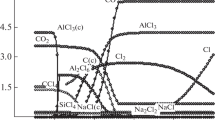Abstract
Crystal-optical, X-ray diffraction, and thermogravimetric methods are used to study the polymorphic transformations in the products of calcination of the aluminum hydroxide produced by the decomposition and carbonization of aluminate solutions; the aluminum oxide produced by the decomposition of pure grade crystal hydrates of aluminum salts; and the alumina extracted upon the beneficiation of the mineral part of coaly rock with sulfuric, hydrochloric, and nitric acids. The morphology of the products of the thermal decomposition of the initial compounds is examined. The effect of impurities and a reducing agent on the formation of the structural modifications of alumina during heat treatment is revealed.
Similar content being viewed by others
References
Joint Committee on Powder Diffraction Standards (IGPOS) (USA, 1975).
A. N. Vinchel and G. Vinchel, Optical Properties of Artificial Minerals (Mir, Moscow, 1967) [in Russian].
M. F. Kompaniets, Crystal-Optical analysis in Aluminum Production (Metallurgizdat, Moscow, 1959) [in Russian].
N. A. Toporov and F. N. Galakhov, On the 70th Birthday of Academician Belyankin (Izd. Akad. Nauk SSSR, Moscow, 1946) [in Russian].
A. M. Kalinina, “Transformation of Synthetic Kaolinite during Heating,” in Chemistry and Technology of Alumina (Kn. Izd., Erevan, 1960), pp. 63–80.
I. Brown, D. Clark, and W. Ellion, “The Thermal Decomposition of the Alumina Trihydrate, Gibbsite,” J. Chem. Soc., No. 3, 84–88 (1953).
G. N. Zviadadze and Yu. A. Lainer, “Chlorine Method of Processing Aluminum-Containing Raw Materials,” in New High-Temperature Processes in Nonferrous Metallurgy, Ed. by N. V. Ageev (Nauka, Moscow, 1981), pp. 65–70.
Powder Diffraction File Search Manual (Norgnic Compounds), Alphabetical Hosting and Search Selection of Frequently Extraction Standards (JCPOS, USA, 1975).
L. I. Mirkin, Handbook for X-Ray Diffraction Analysis of Polycrystals (Gosizdat Fiz.-Mat. Lit-ry, Moscow, 1961) [in Russian].
V. I. Mikheev and E. P. Sal’dau, X-Ray Diffraction Tables for Minerals (Nedra, Moscow, 1965) [in Russian].
A. M. Kalinina, “Relationship between the Structure and Character of the Thermal Transformations between Various Aluminum Compounds,” in Proceedings of the IV All-Union Congress on Chemistry and Technology of Alumina (Nauka, Novosibirsk, 1971), pp. 360–368.
Physical and Chemical Aspects of Adsorbents and Catalysts, Ed. by B. Linsen (Academic, London, 1970; Mir, Moscow, 1973).
A. A. Khanamirova, Alumina and the Methods of Decreasing the Impurity Content in It (Akad. Nauk ArmSSR, Erevan, 1983) [in Russian].
Author information
Authors and Affiliations
Corresponding author
Additional information
Original Russian Text © T.N. Vetchinkina, 2009, published in Metally, 2009, No. 2, pp. 30–40.
Rights and permissions
About this article
Cite this article
Vetchinkina, T.N. Physicochemical properties of the alumina produced by alkaline and acidic methods. Russ. Metall. 2009, 120–128 (2009). https://doi.org/10.1134/S0036029509020050
Received:
Published:
Issue Date:
DOI: https://doi.org/10.1134/S0036029509020050




